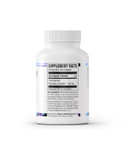Thymoquinone (TQ) – the primary constituent of black seed oil derived from the plant Nigella sativa – has been widely used historically as both food and medicine. TQ has been studied more recently for its beneficial therapeutic effects.* For example, recent research has identified several beneficial effects attributable to TQ’s mechanisms of action, including TQ’s gastrointestinal benefits, inflammatory response benefits, and antioxidant properties.*1-6
Tesseract Medical Research is introducing two powerful formulas based on thymoquinone for practitioners and their patients: ThymoQuell and ThymoQuell Plus. The inherent capabilities of thymoquinone described below are now finally unlocked exclusively by Tesseract and our uniquely powerful molecular delivery system.
ThymoQuell® is a stand-alone thymoquinone formula that addresses inflammatory response and oxidative stress in the gastrointestinal (GI) tract.* Thymoquinone’s propensity to help maintain a normal inflammatory response in the GI tract includes down-regulating inflammatory cascade enzymes,7 as well as certain inflammatory cytokines, tumor necrosis factor-alpha, and C-reactive protein.*7
Thymoquinone has beneficial inhibitory effects on a variety of microorganisms that inhabit the GI tract, thereby supporting GI health by promoting a healthy and balanced flora.* Nigella sativa oil also increases gastric mucin content and glutathione levels, while decreasing gastric mucosal histamine content.* TQ also appears to inhibit gastric acid secretion and neutrophil infiltration during intestinal insult.*8 These numerous beneficial properties make ThymoQuell an excellent choice for individuals experiencing gut dysbiosis, gastrointestinal irritation, non-chronic GI discomfort, or an allergic response affecting the GI tract.*
ThymoQuell might also provide beneficial nutritional support for other conditions characterized by, or resulting from, oxidative stress or an unbalanced inflammatory response, including cardiovascular issues, less than optimal blood pressure, respiratory conditions, and abnormal hepatic function.*9 In addition, thymoquinone has been shown to enhance natural killer cell activity, down-regulate harmful signaling cascades, and inhibit the viability of abnormal cells.*10-13
ThymoQuell Plus® in addition thymoquinone, ThymoQuell Plus includes five other ingredients: turmeric oil and four powerful terpenes – geraniol, borneol, nerol, and farnesol – for enhanced nutritional support of the body’s normal inflammatory responses.*
- Turmeric oil constituents have been clinically shown to have powerful antioxidant properties.*14
- Geraniol is a terpene isolated from several aromatic plants that has been clinically shown to significantly support multiple aspects of intestinal health.*15
- Borneol provides support for the body’s normal inflammatory responses* and is well known for its palliative benefits.16,17
- Farnesol is a terpene derived from several aromatic plants; research shows farnesol improves intestinal barrier function via activation of intestinal cell signaling and enhancing tight junctions.*18
- Nerol is a plant compound shown to inhibit the activity of a variety of harmful microorganisms that can inhabit the GI tract.*19
Tesseract’s ThymoQuell and ThymoQuell Plus are both available in a sustained-released format and are powered by Tesseract's revolutionary CyLoc® and DexKey® delivery system, to ensure optimal absorption – one molecule at a time.
References
1 Ahmad A, Husain A, Mujeeb M, et al. Asian Pac J Trop Biomed 2013;3(5):337-352. doi:10.1016/S2221-1691(13)60075-1
2 Amin B, Hosseinzadeh H. Planta Med 2015;82(1-2):8-16. doi: 10.1055/s-0035-1557838.
3 Hosseinzadeh H, Fazly Bazzaz BS, Haghi MM. Pharmacologyonline 2007;2:429-435.
4 Mohtashami R, Huseini HF, Heydari M, et al. J Ethnopharmacol 2015;175:147-152. doi: 10.1016/j.jep.2015.09.022.
5 Salem ML. Int Immunopharmacol 2005;5(13-14):1749-1770. doi: 10.1016/j.intimp.2005.06.008.
6 Khan MA, Chen HC, Tania M, Zhang DZ. Afr J Tradit Complement Altern Med 2011;8(5):226-232.
7 Hijazy HHA, Dahran N, Althagafi HA, et al. Environ Sci Pollut Res Int 2023;30(6):16597-16611. doi:10.1007/s11356-022-23343-23348.
8 Khan M, Ashfaq M, Zuberi H, et al.. Phytother Res 2003;17:183-186.
9 Al-Ghamdi M. J Ethnopharmacol 2001;76:45-48.
10 Ait Mbarek L, Ait Mouse H, Elabbadi N, et al. Brazilian J Med Biol Res 2007;40:839-847.
11 Gali-Muhtasib H, Roessner A, Schneider-Stock R. Int J Biochem Cell Biol 2006;38:1249-1253.
12 Swamy S, Tan B. J Ethnopharmacol 2000;70:1-7.
13 El-Najjar N, Chatila M, Moukadem H, et al. Apoptosis 2010;15:183-195.
14 Liju VB, Jeena K, Kuttan R. Indian J Pharmacol 2011;43(5):526-531. doi:10.4103/0253-7613.84961.
15 Rizzello F, Ricci C, Scandella M, et al. BMC Complementary and Alternative Medicine 2018;18(1).doi: 10.1186/s12906-018-2403-6
16 Wang S, Zhang D, Hu J, et al. EMBO Mol Med 2017;9(6):802-815. doi: 10.15252/emmm.201607300.
17 Fang Y, Wu C, Wang Q, Tang JFJournal of Bioenergetics and Biomembranes 2019 doi: 10.1007/s10863-019-09817-4
18 Mahmoud AL. Lett Appl Microbiol 1994;19(2):110-113. doi: 10.1111/j.1472-765x.1994.tb00918.x.
19 Almeida JR, Souza GR, Silva JC, et al. Sci World J 2013 Apr 18.. doi: 10.1155/2013/808460.



